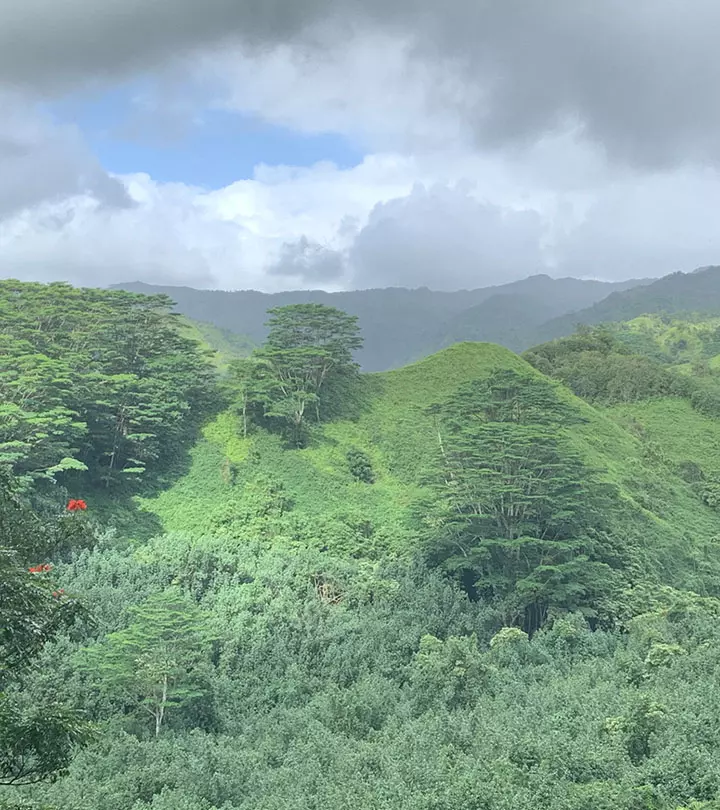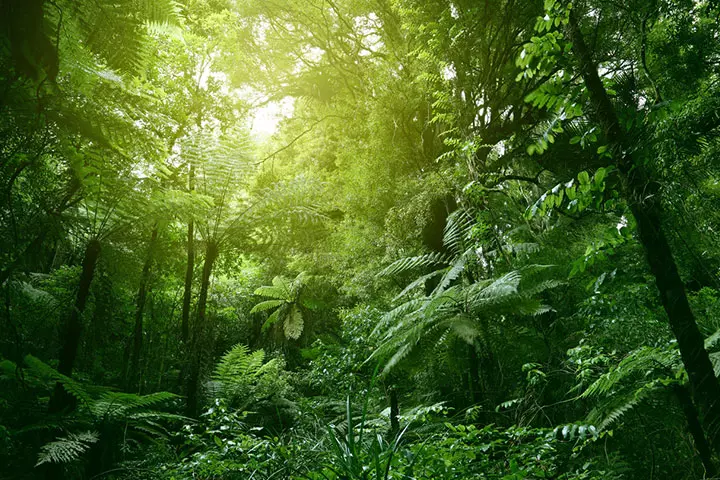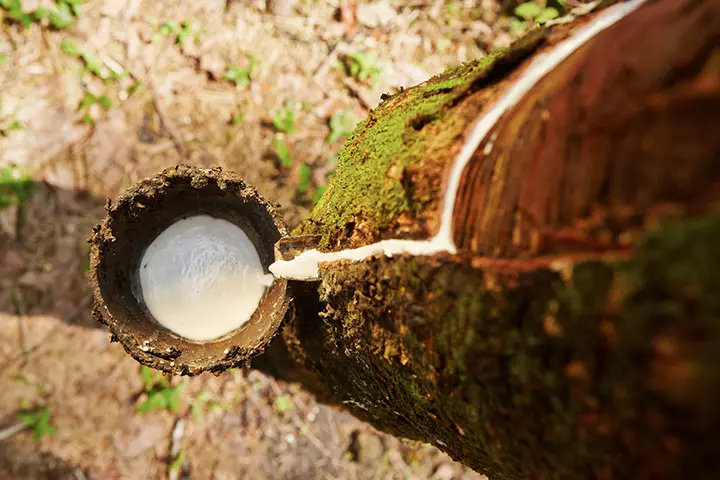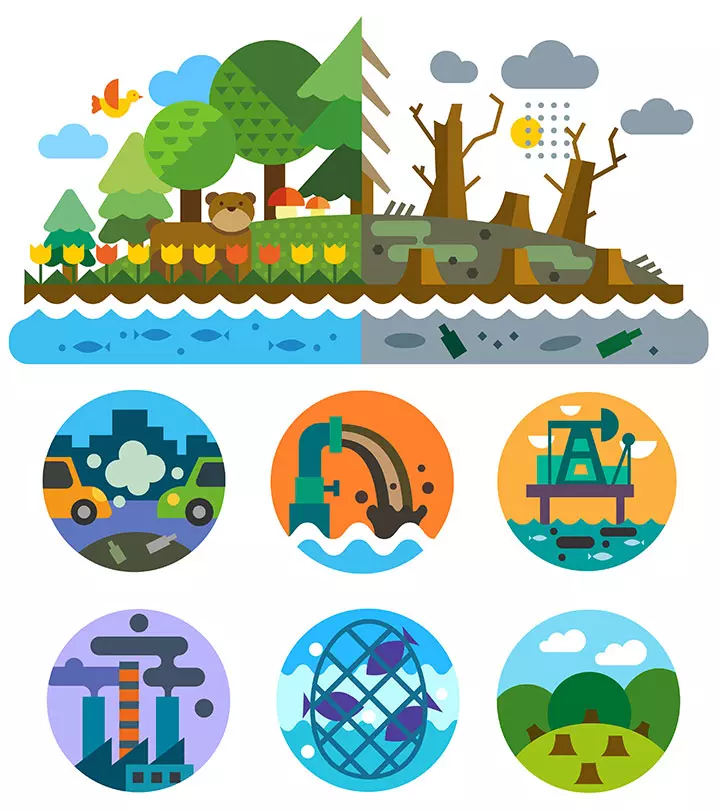
Image: iStock
There are many kinds of rainforests globally, and most of them stay green throughout the year. If you have been looking for some interesting facts about rainforests for kids, you’re at the right place? If you want to upgrade their knowledge, you need to teach children some rare facts about the unique rainforest ecosystem concentrated in only a few areas of the world. We compiled below a list of fun facts about the species of flora and fauna found in this forest and their specific characteristics. So, enlighten your child about the natural resources we get from rainforests and how to conserve this precious forest cover. These incredible facts we have here are mind-boggling and perhaps ones that you’ve never heard of before. Read on to know more about this fascinating ecosystem and be wowed!

Key Pointers
- Rainforests are dense evergreen forests that receive over 100 inches of rain per year, and are rich in biodiversity.
- They can be found in every continent except Antarctica, and are the largest producers of oxygen on Earth.
- Approximately 70% of the plants found in the Amazon rainforest have medicinal properties, some of which are used to treat cancer.
- Due to their dense canopy, sunlight and rainwater struggle to penetrate the forest floor, resulting in a humid atmosphere.
- Unfortunately, deforestation has already destroyed half of the world’s rainforests, posing a significant threat to global biodiversity.
Types Of Rainforests
There are two main types of rainforests, temperate rainforests, and tropical rainforests. Temperate rainforests are found near the coasts of the temperate zones, and tropical rainforests are found close to the equator.
The tropical rainforests remain warm and lush all year round, with the average temperature being anywhere between 70 to 85 degrees Fahrenheit. The temperatures do not change much between day and night. Even the environment is wet in the tropical rainforest, with a humidity of 77% to 87% all day round. Tropical rainforests are known for jaguars and orchids.
The temperate rainforests are not as extensive as the tropical rainforest, primarily because of the cold weather. The temperate forests also get a lot of rain, but because they are not as warm as the tropical rainforests, there are not many plants. There are around 10 to 20 species of trees found in the temperate rainforests, most of which have broad leaves. Temperate rainforests are known for black bears.
 Did you know?
Did you know?Rainforest Facts For Kids

Do you want to know a bit more about the residence of the three-toed sloth and scarlet macaw? Then here are some more fun rainforest facts for children.
- A four square mile patch of rainforest contains as many as 750 species of trees, 150 species of butterflies, 1500 flowering plants and 400 species of birds.
- The trees of the tropical rainforests are so tightly packed that the rains falling on the canopy can take around 10 minutes to reach the ground.
- Rainforests are found on all the continents of the earth, except Antarctica, because it’s too cold for the environment to be conducive.
- There were over 6 million square miles of rainforest, but because of deforestation, less than half of that is found in the world. If the rainforests continue to decline, 5 to 10 species will go extinct every ten years.
- Around 80% of the flowers found in the rainforests of Australia are not found anywhere else in the world.
- Insects make up the majority of the living creatures found in the tropical rainforest.
- Many indigenous people in Brazil and central Africa still live in the rainforests, having absolutely no contact with the outside world. These people depend on the rainforest for their daily needs.
- A fascinating fact about the rainforests is that the tropical rainforests supply the high amounts of oxygen that we take in today.
- Rainforest maintains our provision of safe drinking water. 1/5th of the freshwater is found in the tropical rainforest, the Amazon Basin, to be exact.
- 70% of the plants used for treating cancer are found in the Amazon Rainforest
- Several modern medicines are derived from the compounds found in rainforest plants..
- Due to tremendous rainfall, tropical rainforests have some of the largest rivers in the world, such as Congo, Amazon, Mekong, and Orinoco. Countless creeks, streams, and tributaries feed these rivers. The Amazon River alone has 1100 tributaries, 17 of which are over 1600 kilometers long.
- The Amazon Rainforest is so huge that if it were a country, it would be the ninth-largest country in the world.
- Epiphytes are a type of plant that grows on another plant. These plants are found in the understory layer of the rainforests. These plants start growing on the tree trunks rather than the forest floor because of the lack of light.
- A single area of rainforest is the size of two football fields, having more than 400 species of trees.
- The migratory birds live in the rainforest during the winter and return to the colored regions during summer and spring.
- The rainforests of Europe have 570 species of butterfly, and the Manu International Park, the only reserve in Peru has 1300 species of butterflies.
- Some rainforests receive more than 100 inches of rainfall nearly every year.
- Some pine trees in Tasmania rainforest can live up to 2000 years.
- A lake inside a rainforest on the Caribbean Island of Dominica sizzles at around 88 degrees Celsius.
 Fun fact
Fun factWhat Creates A Rainforest?
Each of the rainforests found on the surface of the earth is unique, but certain features are commonplace to all.
Here are a few common things that make a rainforest.
1. Location
Almost all the rainforests fall in the tropics.
2. Rain
The rain forests get around 80 inches or 20 cm of rain every year.
3. Canopy
Canopy is another characteristic feature of the rainforest. A canopy is a layer of leaves and branches formed due to the closely spaced rainforest trees.
4. Biodiversity
Rainforests have a broad range of biodiversity. Scientists and geologists opine that around half of plant and animal species on the earth’s surface thrive in the rainforests.
5. Symbiotic relationship
The species found in the rainforest work together. For instance- some of the plants found in the rainforests make tiny, house-like structures for the ants. These tiny creatures return the favor by ticking away the insects that try to devour the leaves.
Why Do Rainforests Have A Wide Range Of Animals And Plants?

Tropical rainforests all around the world sustain the highest diversity of living organisms. Even though the rainforests cover less than 2% of the earth’s surface, they contain more than 50% of animals and plant species on the land. The reason for such an extensive profusion of plants and animals in the rainforest are:
1. Climate
Teaching about rainforests can help simplify the process of photosynthesis for kids. Rainforests receive loads of sunlight for being located in the tropical region. The sunlight is transformed into energy by the plants during the process of photosynthesis. This process encourages plant growth in the rainforests.
2. Canopy
The canopy is another major reason for the abundance of plants and animal species. The canopy gives food and shelter to the animals, enabling interaction between the different species. Bromeliads, a type of plant in the canopy, store water in the leaves, which frogs and other animals use for hunting and laying the eggs.
Importance of Rainforest
When you fly over the heart of the Amazon, it feels like flying over an ocean of green. But do you know what is more surprising than the size of the rainforest? It’s the role rainforests play in our lives. The importance of rainforest to the global ecosystem and our well-being is paramount. Let’s look at a few importance of rainforest below!
1. Reservoir of genetic diversity
Rainforests act as a natural reservoir of genetic diversityiThe variety in the inherited DNA within a species , offering a rich source of high yielding foods, medicinal plants and a myriad of other useful products.
2. Habitat for plants and wildlife
Rainforests are home to a large number of animals and plant species, including several endangered species. As many as 40 million species of plants and animals live in the tropical forest. Around half of these plant and animal species in the whole world live in the rainforest habitats. These species can survive only in their natural habitat.
3. Climate stabilizer
Rainforests are called the lung of the planet because of their role in absorbing huge quantities of carbon dioxide and producing oxygen. The excess amount of carbon dioxide in the atmosphere contributes to climate change. Therefore, rainforests play a crucial role in mitigating climate change. But when the rainforests are burned and chopped down, the carbon dioxide stored in the trees is released into the atmosphere, contributing to climate change. Rainforests also affect the local weather by moderating temperature, creating rainfall, and buffering against drought, erosion, and flood.
4. Helps maintain the water cycle
Rainforests add water to the atmosphere through the process of transpirationiThe process through which plants lose water via their stomata . The moisture from transpiration helps in the formation of rain clouds, which are released back onto the rainforest. Cutting down the forest will prevent the formation of the rain cloud, leading to a drastic decline in rainfall. It can even result in drought in extreme cases. The rainforests of the Amazon and Borneo have experienced severe drought in recent years.
Distribution Of Rainforest
Despite the significant role of the tropical rainforests, they are restricted just to a small land area between the Tropic of Capricorn and Tropic of Cancer, near the equator. That’s because the majority of Earth’s and is located north of the tropics. In this region, the sun shines at about the same time all year long, keeping the climate warm and stable. The major areas of tropical rainforests are South and Central America, South East Asia and West Africa.
The global distribution of rainforest is broken into four geographical realms based on four continental regions- the NeotropicaliRelated to one of the most biologically rich regions comprising of Caribbean, South and Central America , The Oriental or Asian, the Ethiopian or Afrotropical and the Australasian or Australian. Over half lies in the Neotropical realm, a quarter in Africa and a fifth in Asia. The remaining 5% are scattered in New Guinea, Australia, and Pacific Islands.
The Amazon rainforest in South America is the largest, unbroken stretch of rainforest in the world. Over half of this forest lies in Brazil. 20% of the remaining rainforest exists between the Congo Basin and Indonesia. The balance of the rainforests is scattered around the tropical regions of the world.
Layers Of Rainforests
There are four layers of rainforest and here is the rainforest layers facts for kids:
1. Emergent layer
Emergent is the top layer of the rainforest. Only the tallest trees can reach this layer. Butterflies, birds, snakes, and small monkeys live in this layer.
2. Canopy layer

As mentioned earlier, the canopy is the thick foliageiA collective noun for leaves or branches of the. Most of the trees grow to this height. Even some plants reach up to the canopy layer, but their roots do not reach the ground. These plants are called air plants. Sloths, monkeys, lizards, snakes and insects live in the canopy layer.
3. Understory layer
The understory is the layer where dense vegetation and vines grow. There isn’t much light in this layer. Frogs, snakes, birds, and butterflies live here.
4. Forest floor
The rainforest floor is humid and dark, with dead plants and leaves. The layer is dark because the trees stop the sunlight from entering the forest. Despite being in constant darkness, the rainforest floor plays a crucial role in the forest ecosystem. Even decomposition takes place on the forest floor. Decomposition is the process by which organic compounds and microorganisms are broken down. The forest floor is also home to wild animals like Asian elephants, jaguars, giraffes, tigers, and tapirs.
What Do We Get From Rainforests?

We get plenty of things from the rainforest, which include:
- Medicines
- Chocolate, as we all know, is made from cocoa. The cocoa pods grow on trees in the rainforests.
- Sugar
- Spices including allspice, ginger, coconut, pepper, cinnamon, paprika, turmeric, vanilla and clove
- Bamboo
- Rubber
 Did you know?
Did you know?Why Are Rainforests Being Destroyed?
Every year, a part of the rainforest as large as New Jersey is being destroyed. The animals residing in this area either perish or migrate to a new forest. But don’t you wonder why the rainforests are being destroyed? What are the main causes? Human beings are the chief reason for rainforest destruction. People are chopping trees for:
- Wood
- Agriculture
- Land
- Pulp for making paper
- Road construction
- Extraction of energy and minerals
What Can We Do To Help The Rainforests?

One way you can help rainforests is by educating more and more people. Children, particularly, should be taught the value of rainforests right from the beginning. Teach them more about plants, animals, and the issues surrounding the deforestation of the rainforests. And most importantly, practice conservation at home.
Frequently Asked Questions
1. What are rainforest soils like?
The soils found in rainforests are generally poor in nutrients due to heavy rainfall and constant uptake of nutrients by plants. They have high levels of aluminum oxides and iron but have low natural fertility (1).
2. Do rainforests have seasons?
Tropical rainforests only have two seasons: wet and dry. Each season lasts for around six months (2). On the other hand, temperate rainforests have a long wet winter and a short summer (3).
3. How do indigenous people depend on the rainforest for their livelihood?
Indigenous people need the rainforest to live because they get food, homes, and medicine from it. They do things like hunting, fishing, gathering things from the forest, and farming in ways that have been passed down through generations. These activities are very important for their survival and their way of life.
4. How do rainforests provide natural medicines?
Rainforests have lots of different plants that can be used as medicines. These plants have special chemicals that can help heal people, and both indigenous communities and modern medicine use them to treat illnesses. People have been using these plants for a long time, and they might have the potential to cure or treat different diseases.
5. How do different layers of the rainforest support various species?
Different parts of the rainforest help different animals because they need different things. The top part of the trees, called the canopy, is where animals that live in trees find shelter and food. The middle part, the understory, has places for animals to hide and make nests. The ground, called the forest floor, has food and protection for animals that live there. And the very top of the trees, called the emergent layer, is a special place for animals that can live up high.
6. How does deforestation affect the balance of the rainforest ecosystem?
When people cut down trees in the rainforest, it upsets the balance of nature. Many animals lose their homes, the soil gets damaged, the way water moves changes, and more greenhouse gases are released into the air. This can harm many different plants and animals, affect the people who live there, and worsen climate change.
7. What are some examples of medicinal plants found in rainforests?
Some of the plants in the rainforest, like the Cinchona tree, Pacific yew tree, and rosy periwinkle, have special chemicals in them. Native people have used these chemicals for a long time to make medicines for diseases like malaria, cancer, and leukemia. Scientists are still studying these plants to see how they can help treat different illnesses.
8. How do rainforests play a role in regulating the Earth’s climate?
Rainforests help control the Earth’s climate by taking carbon dioxide, a greenhouse gas, from the air and giving out oxygen. They also control the temperature and weather by releasing moisture into the air, forming clouds, and reflecting sunlight.
Sharing interesting facts about rainforests for kids can increase their interest in nature and the need to protect nature. Nature coloring pages featuring rainforest scenes can further engage them by allowing them to visualize and interact with these concepts creatively. Temperate rainforests can be near temperate coasts and tropical rainforests near the equator. Tropical rainforests may have more plants due to rain and a warmer climate. Temperate rainforests have comparatively lesser plants due to extreme cold weather. Due to heavy rainfall, tropical rainforests have the largest rivers, such as the Amazon, the Congo, and the Mekong. Insects are the major living creatures in tropical rainforests, and Australian rainforests have more flowers than anywhere else in the world.
Rainforests are the habitat of many plants, birds, and animal species and natural resources. However, rapid urbanization is affecting these rainforests. The following infographic includes interesting facts about rainforests. You can share them with your children to make them interested in environmental protection.
Some thing wrong with infographic shortcode. please verify shortcode syntaxIllustration: Must Know Rainforest Facts For Kids

Image: Stable Diffusion/MomJunction Design Team
Did you know there are two types of rainforests? Learn interesting facts about them here!
References
- Soils and Biomes.
https://serc.carleton.edu/kskl_educator/soil_biomes/chap_7_bkgnd.html - Seasonal changes of the Amazon.
https://wildernessclassroom.org/amazon/2008/10/seasonal_changes_of_the_amazon.html - Rainforest.
https://kids.nceas.ucsb.edu/biomes/rainforest.html - 9 Rainforest Facts Everyone Should Know.
https://www.rainforest-alliance.org/everyday-actions/9-rainforest-facts-everyone-should-know/ - Forest Loss Remained Stubbornly High in 2025.
https://www.globalforestwatch.org/blog/insights/global-tree-cover-loss-data-2025/
Community Experiences
Join the conversation and become a part of our nurturing community! Share your stories, experiences, and insights to connect with fellow parents.
Read full bio of Elisa Yi
Read full bio of Debolina Raja
Read full bio of Harshita Makvana
Read full bio of Kavita Kankani

















